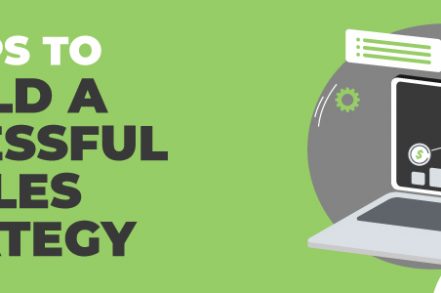A strong sales strategy outlines a business’s sales targets and details exactly how the sales team will achieve them. These strategies are typically developed by company executives but also require the input of sales, marketing, and advertising managers.
It sounds simple enough, but creating a winning sales strategy is something of an art – it requires you to gather the relevant research and bring together a number of operational components into a plan that will get your business where you want and need it to be.
So let’s break it down: here are 8 simple steps to building your successful sales strategy.
1. Research Your Market
Before putting pen to paper, you first need to perform a significant amount of research. Once upon a time, sales strategies were born from blood, sweat, and gut feeling, but since the advent of the data age, guesswork will no longer cut it.
So, what types of questions should your research be asking? Take a fresh look at your market.
- How big is the market?
- Where is the demand?
- Where are customer pain points?
- Do your products solve these pain points?
- What are your most successful competitors doing and are they doing it better than you?
- What’s your current market position, and what are your strengths and weaknesses?
One very effective and popular method of determining your market position is to perform a SWOT analysis.
2. Create an Ideal Customer Profile (ICP) and Conduct Persona Profiling
In addition to researching your target demographic, you should be putting a laser-sharp focus on the customers you want to attract by creating an Ideal Customer Profile (ICP).
Ash Alhashim, President of BFG Consulting and ICP expert, has said that “critical is an understatement” when it comes to the importance of defining an ICP.
He underlined that over the past decade, B2C companies – especially web-first companies – have figured out that they need to be customer-obsessed. In the B2C world, everything revolves around the customer. And B2Bs are finally catching up.
ICPs should primarily consist of demographic attributes such as location, company size, and technological maturity levels. They’re much simpler to pull together than data-heavy personas, and they give you a more top-level view of your demographic than a persona would. However, it’s important to use your ICP alongside personas to boost sales.
If you don’t already have robust, data-informed personas in place, work with your marketing team to create persona profiles using customer data. As well as assisting your sales strategy, these are central to your marketing strategy.
3. Focus on Your Biggest Streams of Revenue
What you think your business looks like and what it actually looks like could be two different things. For instance, you may consider your organization to be a business solutions company, but if 80% of revenue comes from selling one piece of software, then it’s worth reconsidering your sales and marketing efforts.
Analyze your revenue: where is it actually coming from? If something’s really working for you, consider why that particular product or service appeals to your customer base.
If other products or services just aren’t selling and they’re costing you money, is it worth revamping them, attaching them to products that do sell, or will you make more money by just focusing on your biggest stream of revenue?
There are a few ways to look at this, however – it might not simply be the case that one service sells while another doesn’t. Consider whether you generate more revenue by selling to new customers or upselling existing customers. Is cold calling working for you, or do you sell much more when contact is initiated via cold email or LinkedIn? The answer to these questions should inform where you focus your investment going forward.
By directing your time and money towards something that is already working for you, you’re likely to see better results than continuing to actively push a product, service, or sales approach that just isn’t hitting the mark.

4. Create Clear – and Realistic – Revenue Goals
This one is simple. How much revenue can you realistically expect to generate when operating according to your new sales strategy?
Ensure that all revenue-related goals are based on a timeline and that you hold your sales team accountable when they are not reached. But make sure you consult them, too – ask them what they’ll need from you to hit that target.
5. Decide Which Tactics You’re Going to Use
This is where your sales expertise really comes into play. Which sales tactics are going to best help you sell your products and services to hit those all-important revenue goals?
Most likely, you won’t stick to just inbound sales or just one-to-one meetings – the magic formula will be a carefully-balanced mixture of different tactics. Again, listen to what your sales data is telling you – what works for you and what can be axed?
6. Create a Clear Roadmap, With Milestones Along the Way
Create a timeline. What needs to happen at every stage of that timeline to keep your sales strategy on track in order to hit your goals?
Consider not just what needs to happen, but who will be accountable for performing each part of the sales strategy and when each task will need to happen.
7. Get Buy-in From the Team
Achieving buy-in from the sales team, and other related teams such as marketing and HR, cannot be underestimated. These are the people you need to successfully execute your plan. If they’re not fully on-board, even the best plans won’t work.
Include marketing, sales, and HR managers in the process of developing the sales strategy. Additionally, consider any pain points that anyone involved in the strategy may have and ensure these are addressed way ahead of rollout.
8. Regularly Review and Adapt the Strategy
Remember: your strategy is by no means set in stone. It will need to be updated at regular intervals, such as at the beginning of each fiscal year.
There may also be other points in time when it needs to be tweaked, such as following a change of personnel or a realignment of business goals.
Track emails, email reminders & templates in Gmail for free
Upgrade Gmail with the features it’s missing
Add to GmailDavid Campbell
David Campbell is the editor of the Right Inbox blog. He is passionate about email productivity and getting more done in less time.




